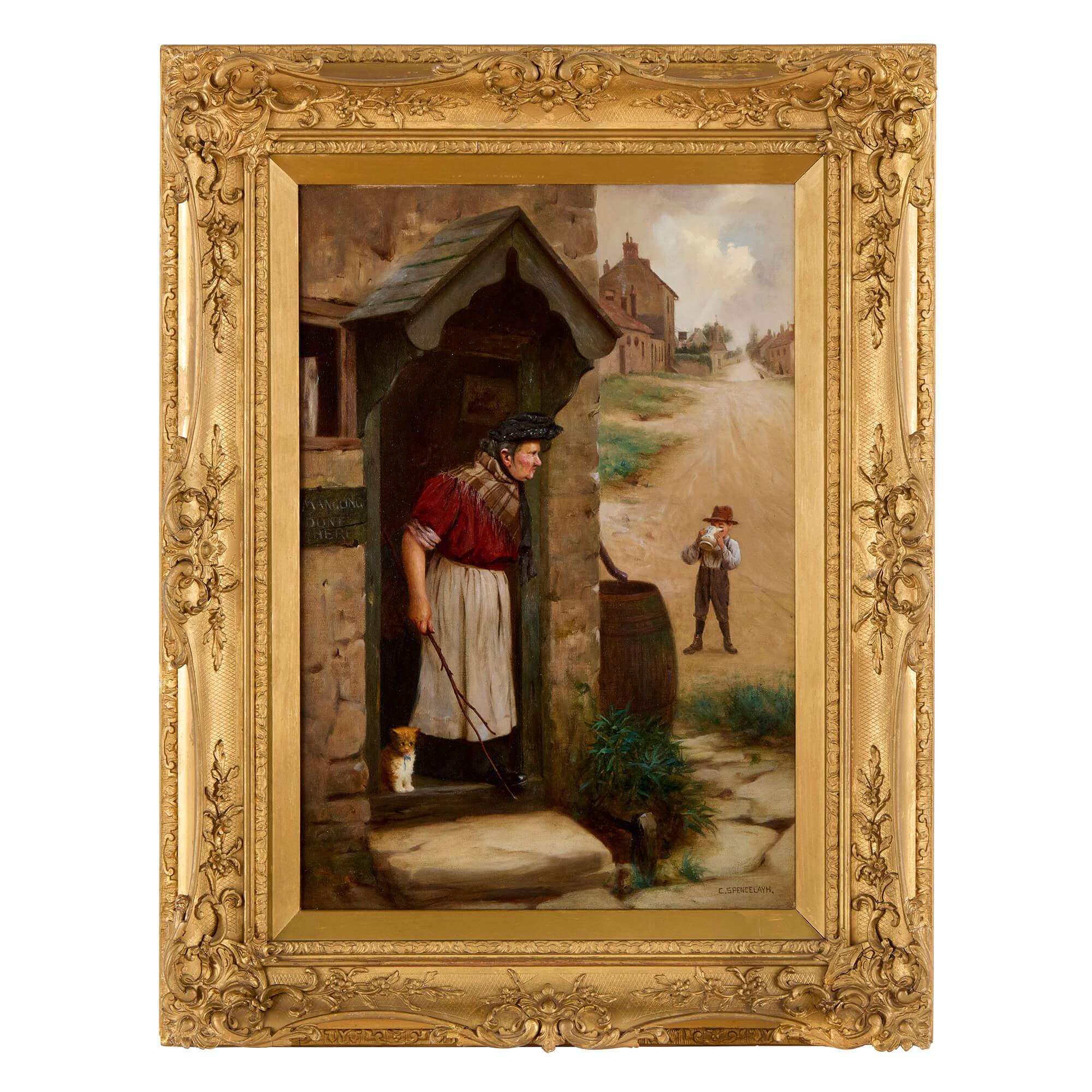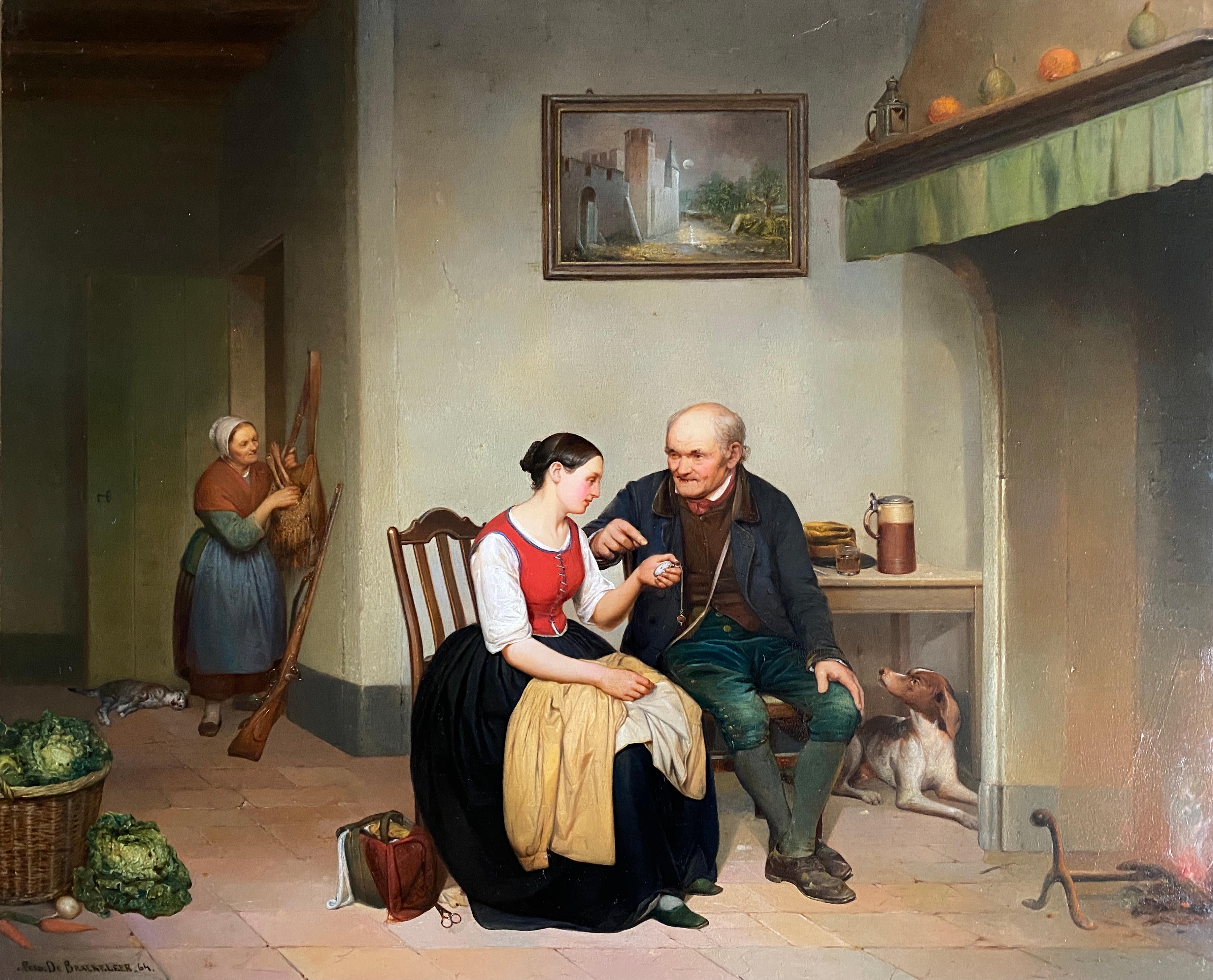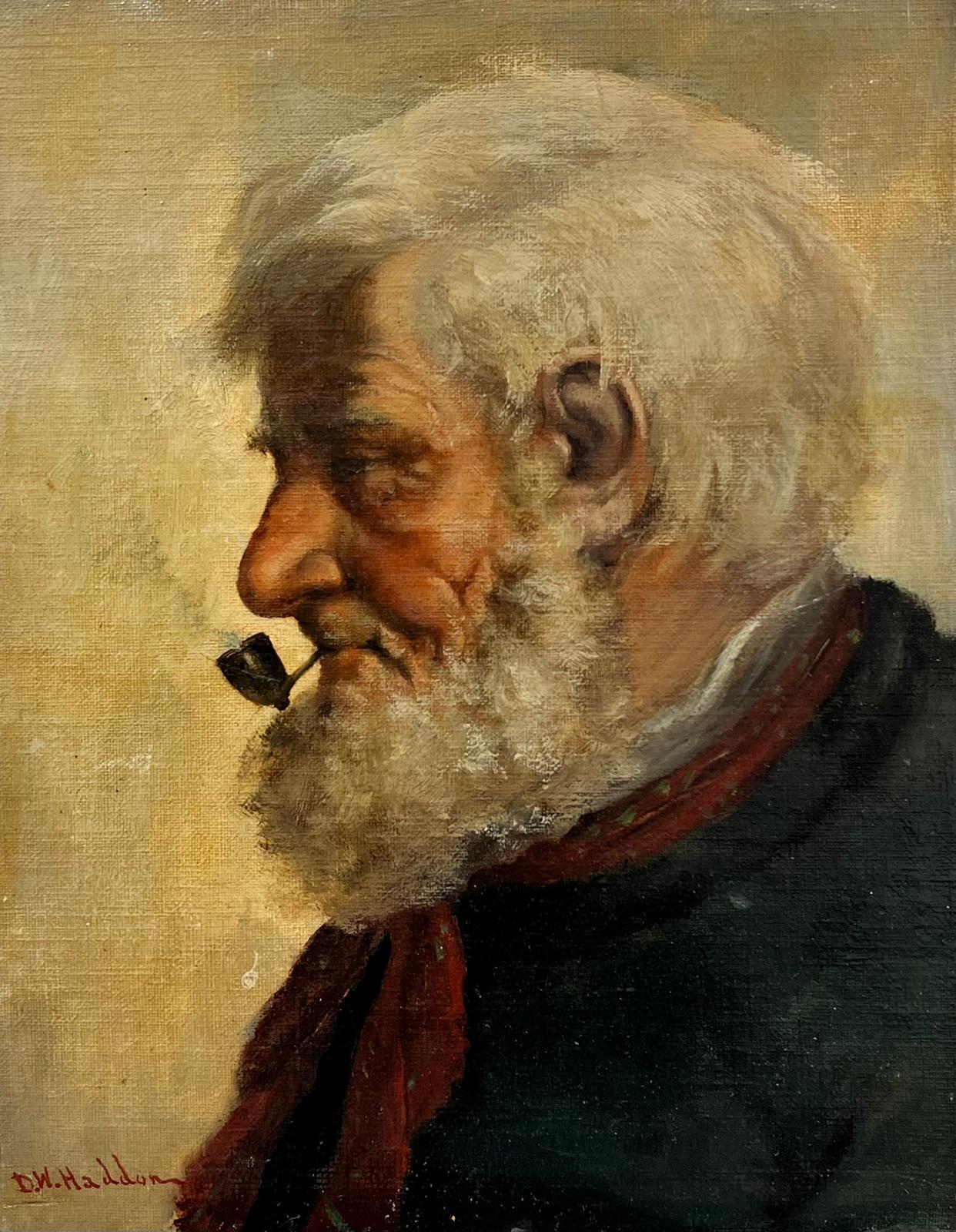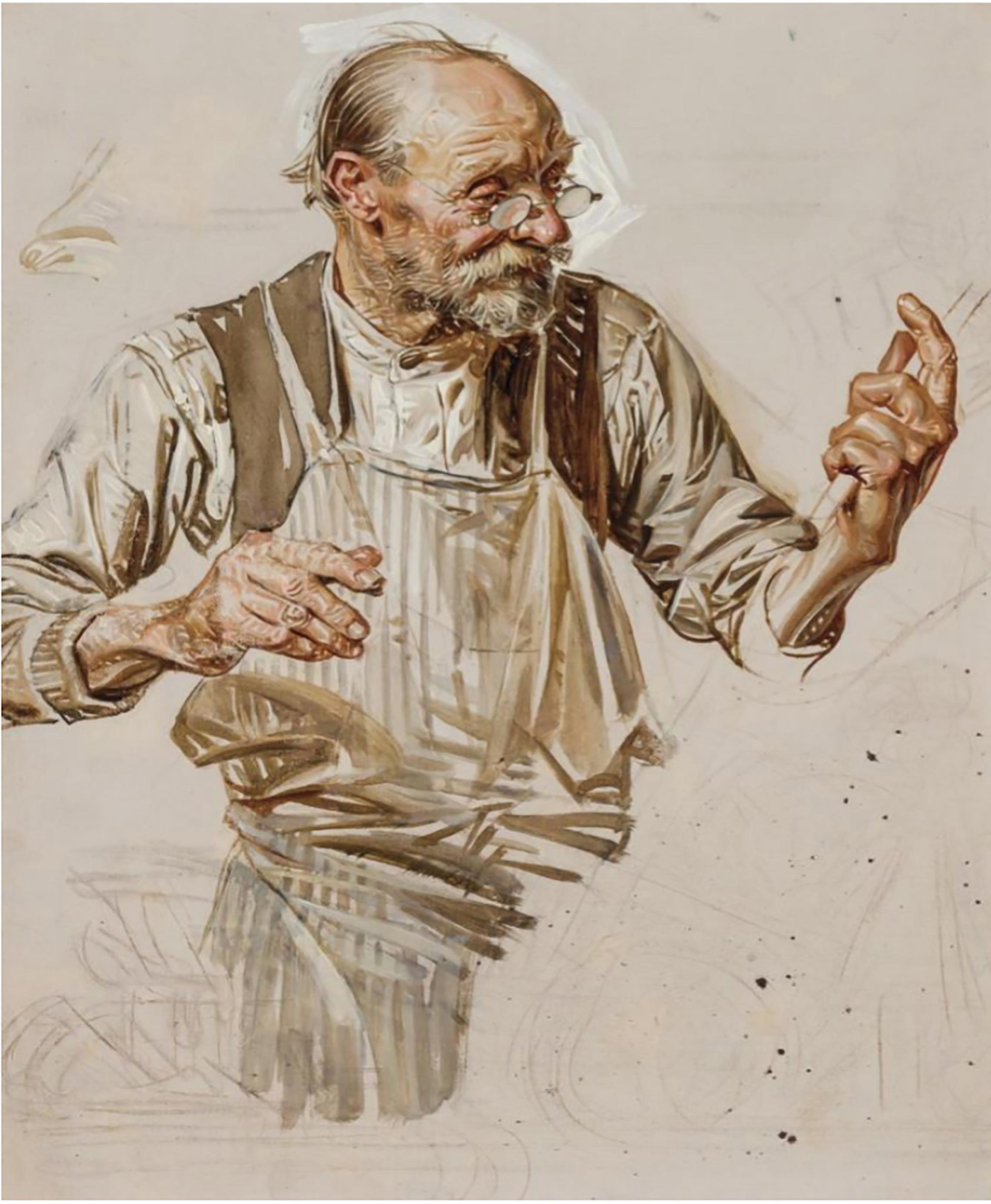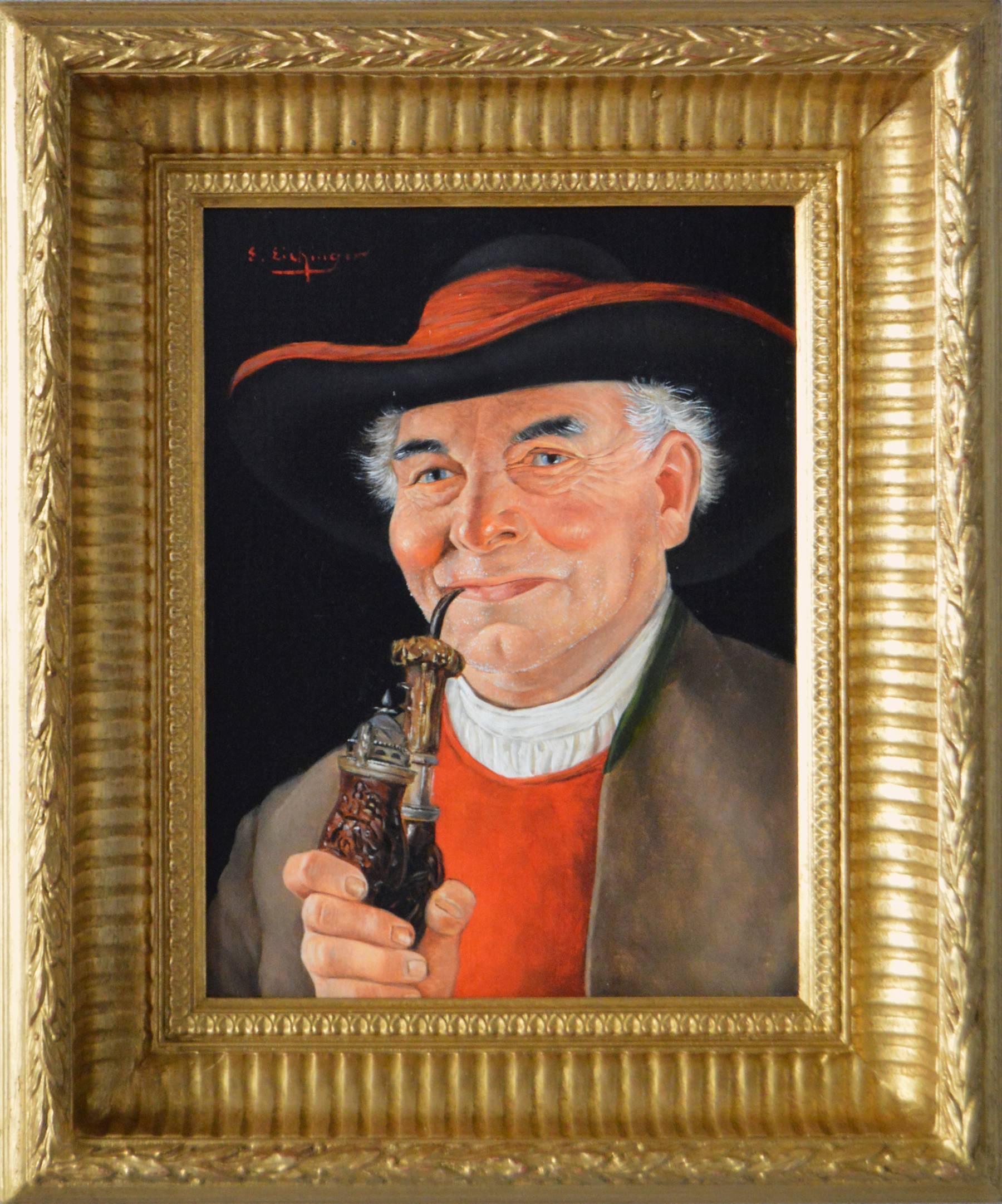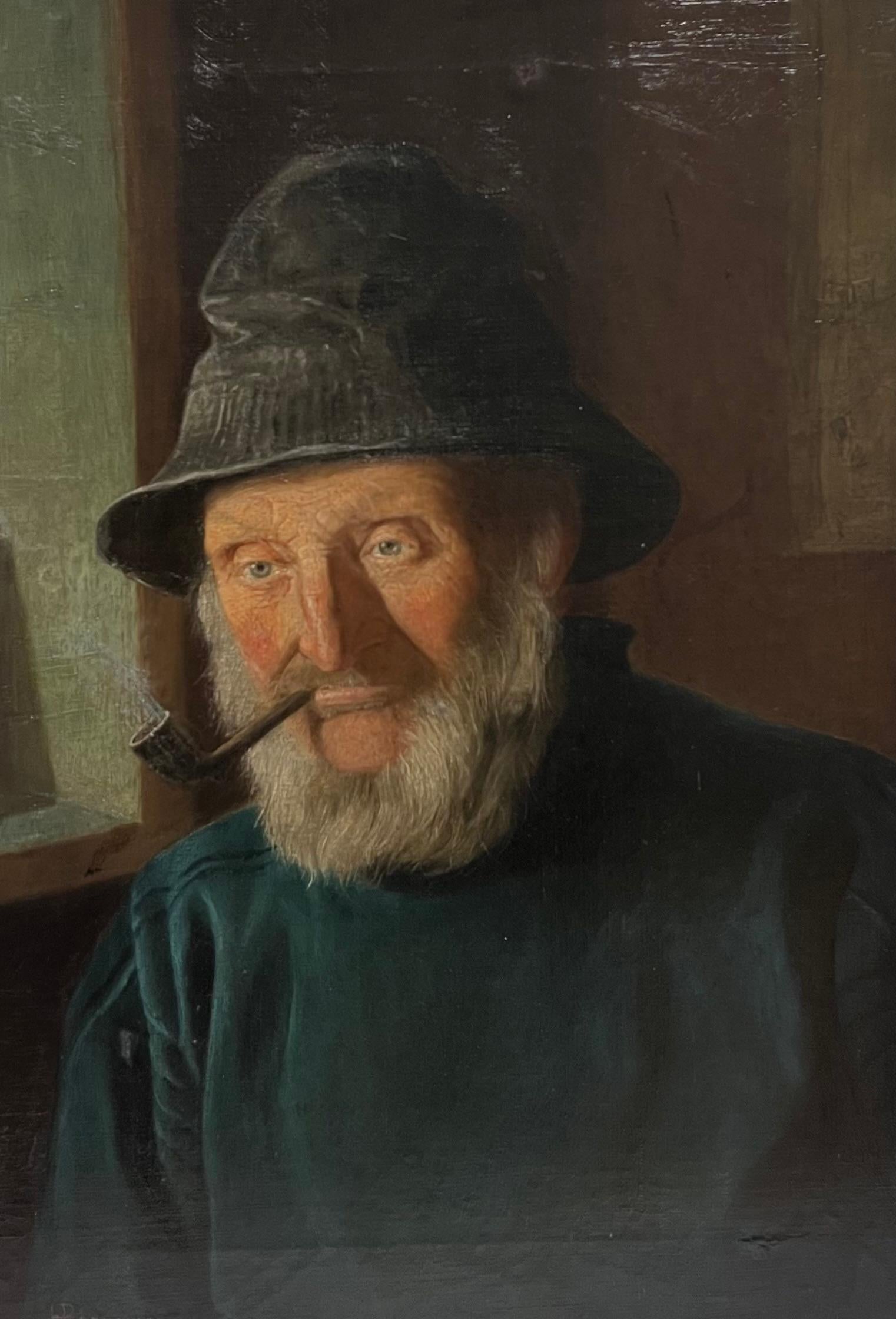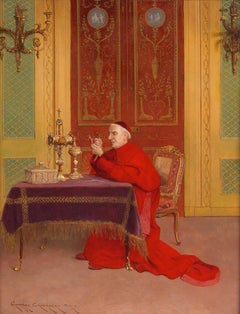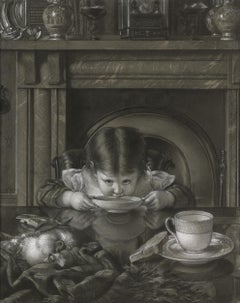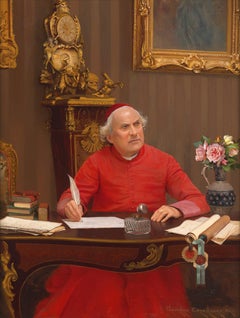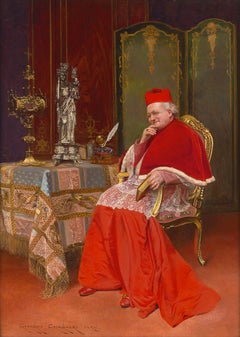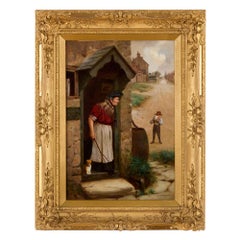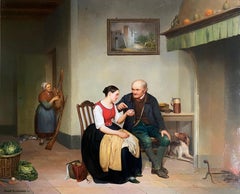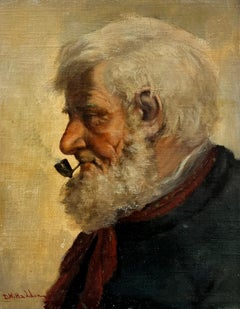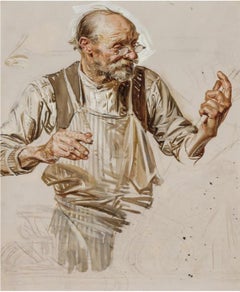Items Similar to The Buttonhole By Charles Spencelayh
Want more images or videos?
Request additional images or videos from the seller
1 of 9
Charles SpencelayhThe Buttonhole By Charles SpencelayhCirca 1940
Circa 1940
$88,500
£67,057.97
€76,809.48
CA$125,350.28
A$136,786.22
CHF 71,746.69
MX$1,661,314.28
NOK 896,155.43
SEK 846,911.70
DKK 573,276.97
About the Item
Charles Spencelayh
1865-1958 British
The Buttonhole
Signed “C.SPENCELAYH” (lower left) and inscribed “This Drawing was accepted into the Royal Academy but crowded out for want of space” (en verso)
Watercolor and pencil with gum arabic on paper
One of the most important English genre painters in the Academic style, Charles Spencelayh's anecdotal scenes are among the best of his age. This work, entitled The Buttonhole, captures the celebrated painter’s preferred subject – an elderly gentleman performing an ordinary task. Spencelayh’s talent for portraying the common man with an engaging sentimentality remains unsurpassed, and his everyday narratives imbue his work with an undeniable timelessness.
He trained at the National Art Training School (later renamed the Royal College of Art), where he flourished in his figural drawings. Spencelayh continued his education in Paris, where he exhibited at the Salon with much success. His primary exhibition venue throughout his career was the Royal Academy, where he showcased 30 paintings from 1912 to 1958. His incredible canvases were hung in the leading art venues of the day and gained him membership into the most prestigious art societies.
During his lifetime, Spencelayh was greatly admired by many influential collectors, including Queen Mary, who provided the artist and his family a residence in Manchester. Spencelayh painted a postage-size portrait of King George V for the Queen’s dollhouse that currently resides in Windsor Castle. Today, his work is highly sought after, though examples rarely become available on the market.
Circa 1940
Paper: 15 1/2" high x 11 3/4"
Frame: 26 1/2" high x 22 5/8" wide
Provenance:
Charles Nicholls & Son, Manchester
Sotheby’s, Chester, 27th April 1989
Private collection, United Kingdom
M.S. Rau, New Orleans
- Creator:Charles Spencelayh (1865-1958, British)
- Creation Year:Circa 1940
- Dimensions:Height: 26.5 in (67.31 cm)Width: 22.63 in (57.49 cm)Depth: 1.38 in (3.51 cm)
- Medium:
- Movement & Style:
- Period:
- Condition:
- Gallery Location:New Orleans, LA
- Reference Number:Seller: 29-40201stDibs: LU18612464732
About the Seller
5.0
Vetted Professional Seller
Every seller passes strict standards for authenticity and reliability
Established in 1912
1stDibs seller since 2013
19 sales on 1stDibs
Typical response time: 10 hours
- ShippingRetrieving quote...Shipping from: New Orleans, LA
- Return Policy
Authenticity Guarantee
In the unlikely event there’s an issue with an item’s authenticity, contact us within 1 year for a full refund. DetailsMoney-Back Guarantee
If your item is not as described, is damaged in transit, or does not arrive, contact us within 7 days for a full refund. Details24-Hour Cancellation
You have a 24-hour grace period in which to reconsider your purchase, with no questions asked.Vetted Professional Sellers
Our world-class sellers must adhere to strict standards for service and quality, maintaining the integrity of our listings.Price-Match Guarantee
If you find that a seller listed the same item for a lower price elsewhere, we’ll match it.Trusted Global Delivery
Our best-in-class carrier network provides specialized shipping options worldwide, including custom delivery.More From This Seller
View AllThe Connoisseur By Georges Croegaert
By Georges Croegaert
Located in New Orleans, LA
Georges Croegaert
1848-1923 Belgian
The Connoisseur
Signed "Georges Croegaert Paris" (lower right)
Oil on panel
A Cardinal peers through a magnifying glass at gilded treasures in...
Category
19th Century Academic Figurative Paintings
Materials
Oil, Panel
L’Heure du goûter! by Jules-Émile Saintin
Located in New Orleans, LA
Jules-Émile Saintin
1829-1894 French
L’Heure du goûter!
(Snack Time!)
Signed "Jules-Émile Saintin" (lower right)
Charcoal and white chalk on paper
A tender moment unfolds as a young girl leans over her bowl of soup, savoring her midday snack with focus and delight. Her spoon rests beside a slice of bread on the polished tabletop, while a cup, perhaps filled with tea or chocolate, and a second piece of bread complete the simple yet cozy scene. Nearby, her stuffed toy lies temporarily forgotten atop a shawl, hinting at the world of play just briefly paused.
The setting is intricately detailed. The dining room showcases a marble fireplace adorned with a clock, fine porcelain and delicate cups. Saintin’s composition captures the quiet grace of the moment as well as the interplay of light and texture, skillfully rendered using only charcoal and white chalk. His ability to infuse luminosity into a monochrome drawing speaks to his refined technique and observational sensitivity. This work resonates with Saintin’s charming studies of children during his American period, such as A Little Girl Dozing Over Her Drawing (possibly a portrait of Jennie Walters), now in the Walters Art Museum in Baltimore.
Born in 1829 in Lemé, Saintin began painting at age 11 and was admitted to the Académie des Beaux-Arts in Paris by 16. Trained under Martin Drölling and Édouard Picot, he became an accomplished portraitist and debuted at the Salon des Artistes Français in 1848, earning several medals.
In 1853, he moved to New York to work in a photography studio, soon dedicating himself fully to painting. He exhibited regularly at the National Academy of Design—becoming a member in 1858—and gained a strong reputation for his portraits of American elites, as well as for his depictions of landscapes and Native American clothing...
Category
19th Century Figurative Drawings and Watercolors
Materials
Paper, Chalk, Charcoal
The Letter By Georges Croegaert
By Georges Croegaert
Located in New Orleans, LA
Georges Croegaert
1848-1923 Belgian
The Letter
Signed "Georges Croegaert Paris" (lower right)
Oil on panel
A cardinal pauses while composing a letter in this oil on panel by Belg...
Category
Late 19th Century Academic Figurative Paintings
Materials
Oil, Panel
An Amusing Thought by Georges Croegaert
By Georges Croegaert
Located in New Orleans, LA
Georges Croegaert
1848-1923 Belgian
An Amusing Thought
Signed "Georges Croegaert Paris" (lower left)
Oil on panel
This oil on panel by Belgian artist Georges Croegaert is a rich ...
Category
19th Century Academic Figurative Paintings
Materials
Oil, Panel
Tender Years: Moth Holes by Norman Rockwell
By Norman Rockwell
Located in New Orleans, LA
Norman Rockwell
1894-1978 American
Tender Years: Moth Holes
Signed "Norman Rockwell" (lower right)
Oil on canvas
From Norman Rockwell's acclaimed Four Seasons calendar series for...
Category
20th Century Figurative Paintings
Materials
Canvas, Oil
No Love Without Envy by Eugene Von Blaas
By Eugene von Blaas
Located in New Orleans, LA
Eugen von Blaas
Italian I 1843-1932
No Love Without Envy
Signed and dated "Eugen von Blaas 1901" (lower right)
Oil on canvas
Eugen von Blaas masterfully captured the spirit and charm of Venice, and No Love Without Envy stands as one of his most exceptional compositions. Larger and more finely detailed than many of his works, this grand painting reflects his unparalleled mastery of light, color and narrative. Rich in detail and emotion, this scene is believed to feature a stylized self-portrait of the artist alongside his wife, Paola Prina.
Set in a sun-drenched Venetian courtyard, the composition brims with life and intrigue. At its center, an orange seller—modeled by Prina—engages in a flirtatious exchange with an admirer, the artist himself, while three onlookers observe with amusement and envy. The interplay of light and texture is remarkable: von Blaas' exquisite brushwork renders the delicate lace, sumptuous fabrics and intricately adorned garments with near-photographic precision, while the soft flesh tones contrast beautifully against the timeworn stonework of Venice. This attention to detail, combined with the work’s luminous palette, creates a sense of immediacy and warmth that defines the best of von Blaas' Venetian genre paintings.
Born in 1843 to Austrian parents in Italy, von Blaas was raised in a household steeped in artistic tradition. His father, Karl Blaas, was a renowned portraitist and history painter, while his brother specialized in military scenes. When Karl was appointed professor at the Venice Academy of Fine Arts, the family relocated to the floating city—a move that profoundly shaped von Blaas’ artistic vision. Though he studied in Rome, Vienna and Paris, it was Venice that remained his greatest muse. Captivated by its light, architecture and everyday moments of romance and social interplay, he became the foremost painter of Venetian genre scenes.
During Venice’s Austrian rule, von Blaas adopted the Italianized name “Eugene de Blaas...
Category
20th Century Academic Figurative Paintings
Materials
Canvas, Oil
You May Also Like
Large Antique English Victorian Figurative Oil Painting Charles Spencelayh
By Charles Spencelayh
Located in London, GB
Large Antique English Victorian Figurative Oil Painting Charles Spencelayh
English, c. 1900
Canvas: Height 53cm, width 37cm
Frame: Height 72cm, width 56cm, depth 7cm
Presented here ...
Category
Early 20th Century Victorian Figurative Paintings
Materials
Canvas, Oil
An Old Man Pointing at Pocket Watch, Artist 19th Century, European School
Located in Knokke, BE
An Old Man Pointing at Pocket Watch
Artist 19th Century
European School
Signature: Signed bottom left
Medium: Oil on panel
Dimensions: Image size 46 x 55,50 cm
Category
19th Century Realist Interior Paintings
Materials
Oil, Panel
Cornish Fisherman Smoking Clay Pipe Antique British Signed Oil Painting
Located in Cirencester, Gloucestershire
The Cornish Fisherman
signed D.W Haddon (British, active 1884-1914 in Cornwall)
oil on canvas on board, unframed
board: 11 x 9 inches
provenance: pri...
Category
19th Century Victorian Portrait Paintings
Materials
Oil
$933 Sale Price
20% Off
Toy Maker Study
By Joseph Christian Leyendecker
Located in Fort Washington, PA
Medium: Oil on Canvas
Signature: Signed Upper Left
Category
20th Century Figurative Paintings
Materials
Canvas, Oil
Portrait oil painting of an Austrian Gentleman with a Pipe
By Erwin Eichinger
Located in Nr Broadway, Worcestershire
Erwin Eichinger
Austrian, (1892-1950)
The Pipe
Oil on board, signed
Image size: 10 inches x 7.5 inches
Size including frame: 15.25 inches x 12.75 inches
A finely painted portrait ...
Category
Early 20th Century Victorian Portrait Paintings
Materials
Oil, Board
1890's Portrait Painting of Whitby Fisherman in Yorkshire England Large Oil
Located in Cirencester, Gloucestershire
Portrait of Cud Colley - the Whitby Fisherman
by Henry Borrows (British, painted 1878-1891)
signed oil on canvas, framed
dated 1891
framed: 27 x 21 inches
canvas : 22 x 16 inches
Pro...
Category
Late 19th Century Victorian Portrait Paintings
Materials
Oil
More Ways To Browse
Vintage Chester
M Charles
King George V
Queen Mary Vintage
Portrait King George
Portrait Of King George
Drawing In Sanguine
Italian Watercolor Artist
Matisse Watercolour
Nude Woman Artwork
Robert Avery
Southern Gothic
Watercolor Death
Henry Miller Watercolor
African American Art Watercolors
Amate Paper
Anais Nin
Vintage Cabaret Dancers
